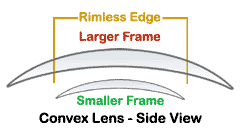

A single vision lens is a mono visual lens yielding a single field of vision; whether there is no prescription or a single RX prescription. The three forms of single vision lenses are plano, concave (minus prescriptions) and convex (plus prescriptions). There are several different materials to accommodate different needs, lifestyles and prescriptions. View our Materials/Mediums links for more information on the technology available to accommodate patient needs with lens materials.
Plano lenses are consistently the same thickness throughout the lens. This anatomy of the lens yields no prescription and is commonly used in all retail sunglasses and eyeglasses that do not require a prescription.

Concave lenses are used to address nearsighted correction, also referred to as Myopia. Myopia patients are usually identified with a minus diopter sphere on an RX prescription. The anatomy of this lens consists of a thinner center and thicker edge. The mass of the edges on a concave lens is dictated by the severity of the prescription. The higher the minus diopter sphere on the RX (prescription), the thicker the edge will be. The lenses for minus prescriptions have a flatter front base, hence yielding a flatter lens. For this reason some minus prescriptions are hard to fit into a wrap around frame (i.e. sunglasses).
Concave (minus sphere) lenses tend to de-magnify the appearance of the eye making the eye look smaller than normal. The higher the myopic (minus) prescription the more notable the de-magnification of the eye is, making the eye look smaller than normal. An aspheric lens should be considered, especially with higher myopia (minus) prescriptions. An aspheric lens will help create a thinner lens and a more natural aesthetic appearance of the eye. However, even with an aspheric lens the eye may still appear smaller than normal with higher myopia (minus) prescriptions.
Standard center thickness of a lens is 2.2mm. However, there are certain materials that can be surface to a 1.0mm center thickness, making the lens consistently thinner. There are other factors to consider, please consult your Optician to comply with individual specifications. Combining smaller frames with a higher index lens (see Materials/Mediums); patients can achieve the thinnest lens possible for their respective prescription.
One common recommendation on high minus prescriptions is a smaller frame. Considering that the closer to the center you get on a concave lens the thinner the lens is, hence the smaller the circumference of the eye size of the eyeglass frame the thinner your lenses potentially will be (see concave lens image below).

Convex lenses are made to accommodate farsighted patients, also referred to as Hyperopia. Hyperopia patients are identified with a plus sphere on an RX prescription. The anatomy of this lens is thicker in the middle and thinner on the edges (see convex lens image below). Convex (plus sphere) lenses have a curved front base, yielding a curved lens that can accommodate many frames styles.
Convex (plus sphere) lenses tend to magnify the eye. The higher the plus prescription the more notable the magnification of the eye is, creating a bug eye or "Coke bottle" effect. An aspheric lens should be considered, especially with higher hyperopia (plus) prescriptions. An aspheric lens will help create a thinner lens and a more natural aesthetic appearance of the eye for the wearer. However, even with an aspheric lens the eye may still appear larger than normal with higher hyperopia (plus) prescriptions.
The higher the plus prescription the thicker the the center will be. Considering the edge of the lens can be as thin as a dull knifes edge, the center thickness proportionally increases and decreases with the edge of the lens. So the smaller the frame the thinner the center thickness will be in ratio to the lenses edge. The larger the frame the thicker the center thickness will be in proportional ratio with the lenses edge (see convex lens -side view image below). The Image below represents the same prescription compared in a larger and smaller frame.
Another point to consider with convex (plus Sphere) lenses is the higher the plus prescription the less recommendable these lenses are for rimless (drill-mount) and semi-rimless (rimlon) frames. A rimless and semi-rimless lens has to have a designated edge thickness to accommodate a groove, or girth to sustain an elbow/temple of a drill mount frame. Considering that the edges of the convex lens can be as thin as a dull knifes edge; having to create a thicker edge to accommodate a groove or drill mount frame increases the overall thickness of the lens. Please refer to the "Convex Lens-Side View" image below. The rimless cut out on the larger frame should be compared to the smaller frame in reference to the lens thickness comparison between a full framed lens to a rimless framed lens. The rimless edge may be thinner than the image portrayal, but regardless will always be thicker than a full framed lens. Again, this is only to be considered on higher plus prescriptions. Consult with your Optician for specific recommendations.
